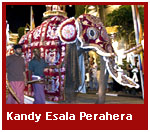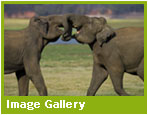|
 |
Other
Places to Visit |

|
Addhisham
A few kilometres from Haputale in Colombo - Kandy
road lies the Benedictine monastery Addisham.
The garden is home to blue magpies, paradise flycatchers,
green barbets, brilliant orange plumaged mini-verts
hornbills, golden orioles & a host of other
bird life.
Originally the country seat of Sir Thomas Villiers.
The spirit of Thomas Lister Villiers strongly
pervades this stately house. Villiers came to
Ceylon in 1887 with 10 sterling pounds in his
pocket. He was born in 1869 in Addisham Rectory
in Kent, the son of Rev Henry Montague Villiers.
He was a grandson of Lord John Russell, twice
prime minister of Britain.
Villiers received a public school education
but instead of settling down to a business or
political career in England chose adventure
in the colony of Ceylon. Soon after his arrival,
he began life as a trainee planter In 1905 Villiers
joined the firm of George Steuart, a trading
and estate agency house in Colombo, and rose
to be its chairman in 1928, a position he held
till retirement in 1948. He also played a role
in Ceylon politics.It was while he was chairman
of George Steuart that Sir Thomas commenced
building a dream home in the country. He selected
an idyllic site at Haputale, surrounded by virgin
forest and commanding views across hills and
valleys and the highest mountain ranges of Ceylon.
The house was designed in the Tudor style, on
the lines of Leeds Castle in Kent, with stout
granite walls of locally quarried stone, long,
narrow turret windows and chimneys. It looked
in every detail an Elizabethan country mansion,
the retreat in the tropics of a homesick Englishman,
nostalgic for the scenes of his boyhood. Villiers
spared no expense to ensure that his country
home was luxurious in its appointments. The
roof was covered with flat Burma teak shingles.
The doors, windows, paneling, staircase and
floors were all of Burma teak. The elaborate
pillared landing on the main staircase adorned
by portraits of his relatives, the Clarendons
and the Dukes of Bedford, consists of four stout
English oaks, polished, but otherwise natural.
Villiers imported fine period furniture, linen,
carpets, porcelain, silver, and glassware from
England for his home and named it Addisham after
the Kentish village where he was born. The garden
lay-out was also British English tea and cabbage
roses bloomed on the lawns. Albertines and honeysuckle
climbed over the porches and windows; strawberries,
apples and Victoria plums ripened in the cool
mountain air and the tropical sunshine, and,
as in the house, the incomparable scenery is
used to best effect. The terraced lawns, flowerbeds
and orchard, like the drawing room, study, library,
dining room and bedrooms, look out on lofty
mountain ranges, Today it is run as a monastery,
which runs a domestic industry of food products
such as jams & jellies from wild guavas
& the produce of fruit cordials.
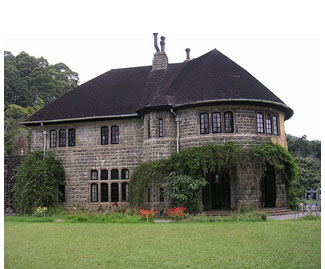
|
Dambulla
Arboretum
This land is the only arboretum
to be found in the dry zone, established in 1963
by Mr Sam Popham, a man simply motivated by the
abiding interest in the love of trees. In 1992
He was awarded the first Lanka Conservation Award
in recognition of his work. He has now returned
to live in England. When Mr Poham arrived the
property (originally covered with semi –evergreen
forest) was overrun by scrub jungle due to chena
cultivation. The woodland, a 27 acre property
was acquired and added on to the property in 1989.
Popham’s initial aim was to clear the scrub
and replace it with native trees, however he soon
found a unique method that not only achieved his
aims but allowed the arboretum to rejuvenate with
minimal human interference. This method came to
be known as the ‘Popham method’ The
method was influenced by his dislike of tampering
with nature. By clearing away the scrub jungle,
seedlings of the previous evergreen forest were
released. These seedlings were acclimatized to
cope with the harsh conditions of the dry zone.
Popham in fact found that these seedlings grew
and prospered much better than seedlings brought
in from outside nursuries. Apart from the majestic
trees and shrubs you can find here, it is also
an excellent place for bird watching where many
varieties of bird can be seen. Another undeniable
attraction at this arboretum is the houses where
Sam Popham lived, one of which was built by the
illustrious architect Geoffrey Bawa and today
serves as a visitor center.
|
Elephant
Orphanage
Pinnawala Elephant Orphanage which is situated
in the Kegalle district opened in 1975 with a
land area of 10ha for the sole purpose of taking
care of orphaned Elephants who were found in the
jungles lost and separated from their herds or
those who have sustained injuries caused either
naturally or by poachers. It commenced with seven
orphans and today, some of these orphans enjoy
the fortune of seeing their grand children born
in the same location. Currently it is home for
over 70 baby and semi adult Elephants. At this
Orphanage one can get the opportunity to watch
the Elephants bathing and having fun in the nearby
river, you can also see the baby Elephants being
fed, and get the opportunity to bottle feed one
yourself. You can also ride an Elephant if desired.
With the opportunity to get close to this magnificent
animal All in all this experience is one that
you simply cannot miss. The Orphanage is Equipped
with an excellent restaurant for your refreshments,
a small snack or even a wholesome meal.
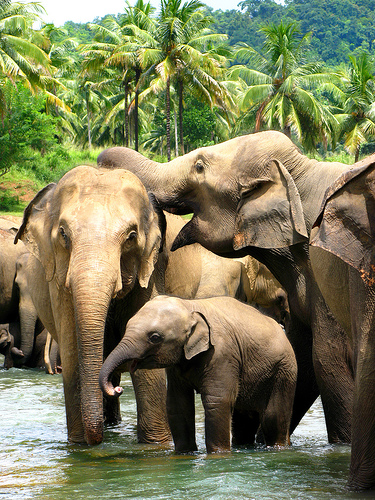
|
Kudawella
Blow Hole
The Kudawella Blow Hole, a site that is breathtakingly
mysterious. Volumes of sea water whistle through
a natural fine hole from beneath a massive rock
in the sea. Located on a rock about 40 ft above
sea level, this magnificent site was first discovered
after a close scrutiny of photographs taken from
the sea.
At the site, rough and high waves push water into
the triangular based rock bottom, and force it
through a hole at the bottom of the rock with
very high pressure. With the sound of a blow whistle
the water is blown high into the air. Approaching
this place, one can find many small outlets selling
local fruits, thirst quenching drinks and the
all time favorite fresh fried fish. In addition
to this you will also find souvenir shops with
a variety of local handicrafts and ornaments made
out of sea shells and other marine findings
.JPG)
|
National
Museum
The Colombo museum as it was called at the beginning
was established on 1st January 1877. It founder
was sir William Henry Gregory the British Governor
of Ceylon (Sri Lanka) at the time. The Royal Asiatic
Society (CB) was instrumental in bringing to the
notice of Gregory on his appointment as Governor
in 1872 the need for a public Museum with much
difficulty the approval of the legislative council
was obtained within a year. The Architect of the
Public Works Department, J. G. Smither was able
to prepare the plans for new structure on Italian
Architectural style. The construction was completed
in 1876 and the Museum commenced it functions
in the following year.
With the development of the museum to international
level, it earned the status of a national museum
and the installation of the Throne and crown
of the last king of Kandy which were handed
over back to Sri Lanka by the British Government,
has greatly enhanced the quality of the museum
collection. In spite of the enormity of the
various collections thematic arrangement of
the galleries has provided and opportunity to
visitors to study the ancient culture of the
Sri Lanka under one roof. This process has further
been improved by the arrangement of the galleries
of the ground floor in a historical sequence
and those of the upper galleries on a thematic
basis.
The National Museum is open to the public from
8.30 am to 5.00 pm daily except for Sundays
and government holidays.
Other Museums that can be visited
National Museum Kandy
National Museum Galle
National Museum Ratnapura
National Museum Maritime Galle
Sigiriya Museum
Colombo Dutch Period Museum
Folk Museum Anuradhapura
Walisinghe Harischandra Museum Katana (Negombo)
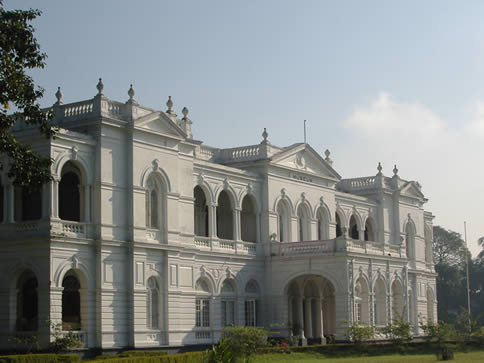
|
Viharamahadevi
Park
Viharamahadevi Park, is a public park located
in Cinnamon Gardens, Colombo, in front of the
colonial style Town Hall building. It is the only
public park in Colombo, and is maintained by the
Municipal Council of Colombo.
Like many roads and places in Colombo, the Viharamahadevi
Park is a rename of a park created by the British.
Originally named Victoria Park after Queen Victoria,
it was renamed in 1958 as Viharamahadevi Park
in honor of a Sri Lankan girl named Viharamahadevi,
who would one day be queen, Viharamahadevi was
born poor, and was cast adrift as a sacrifice
to favour the gods. she was rescued off the coast
at Kirinda by King Kavantissa, who took her as
his wife. Her only significance in history is
for having a son, Dutugemunu, who managed to wrestle
Anuradhapura back from the conquering Cholas of
South India
Viharamahadevi park still referred to as Victoria
Park by some of the city's dwellers. It is notable
for its elegant flowering trees, which bloom in
March, April and early May, the huge Buddha statue
and a series of water fountains. It also includes
a mini zoo, and a children's play area.
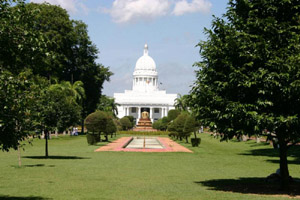
|
Waterfalls
of Sri Lanka
The island is blessed with 103 rivers and streams
radiating from the central hills, rushing down
rocky precipices forming a number of roaring waterfalls
of various shapes and heights, all ending up loosing
the momentum at the Indian Ocean.Here are some
of the most picturesque waterfalls, out of which
only a few can be viewed with ease, where as the
others can only be seen by penetrating thick forests
and tea plantations.
1. Bambarakanda Ella The highest
waterfall in Sri Lanka (865 feet), which is at
it`s peak capacity during September and October.
2. Diyaluma You will find the
2nd highest waterfall around 13 Km towards "Koslanda"
on the Wellawaya Road. Diyaluma means
Watery light.
3. Dunhinda To see the breathtaking
beauty of Dunhinda falls(210 feet), you have to
travel about 5 Km from Badulla along the
Mahiyangana road, and
walk for another 2 Km (trekking) away from the
main road.
4. St. Claire The widest waterfall
in Sri Lanka, about 265 feet high on the Hatton-Nuwaraeliya
road near Talawakelle
5. Laxapana Falls Laxapana fall
is 377 feet high, can be viewed on the Hatton-Colombo
road
6. Aberdeen Falls A mere 5 Km
away from Laxapana you will find the 322 feet
high Aberdeen Falls.
7. Devon Falls Devon falls(318
feet) can be best viewed from the 20th mile post
of the Talawakele-Hatton highway.
8. Rawana Falls Visible from
the Ella-Wellawaya road, near Udunuwara village.
A popular stopover for travelers.
9. Alupola Ella This 200 feet
high fall is to be found 25 Km away from Ratnapura
in the Wewalwatte village.
10. Bopath Ella The water falls
100 feet in the shape of a Bo leaf. When you travel
along the Colombo-Ratnapura highway, turn at
Higasthenna junction
and drive along the Agalawatte road up to Devapahala
village to see Bopath Ella.
11. The Lovers Leap The 100 feet
high Lovers Leap begins it`s journey as a fountain
at the Southern slope of Sri Lanka`s highest
mountain.
Pidurutalagala. The falls can be seen from the
town Nuwara Eliya.
12. Mawanella Ella Travel 35
Km from Nuwara Eliya towards Udupussallawa and
another 13 Km towards the Napola gap, and then
you
will find.
Mawanella Ella in the Lunuwatta village.
13. Bakers Fall Discovered by
Sir Samuel Baker and a good stopover on your way
to the World`s end.
14 Elgin Falls Railway
between Nanu Oya and Ambewela offers a panoramic
view of the 75 feet high Elgin Falls.
15. Bridal Falls The winding
highway to the Nuwara Eliya Plateau offers a memorable
view of Bridal Falls, resembling a bridal veil,
while dropping
over the rock face.
16. Perawella Falls Perawella
Fall is about 90 feet high.
17. Ramboda Falls Can be seen
from the Ramboda Bazaar on the Nuwara Eliya-Ramboda
road.
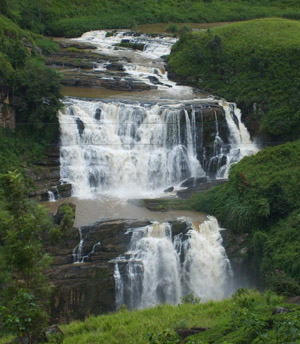
|
Zoological
Gardens
Situated in Dehiwala, a Colombo suburb approximately
11 kms from Colombo Fort area is the Zoological
gardens which has a extremely large and fine collection
of well over 3000 animals and 350 species as well
as a large collection of birds brought from all
over the world and is one of the finest zoological
gardens in Asia.
Popularly known as the Dehiwala zoo which was
found in 1936, this menagerie covers around
30 acres beautifully landscaped to provide more
natural habitats, some lawns of the Zoo have
been converted into small forest patches which
are rich in rare plants. Valuable medicinal
plants are prominent among the trees in these
patches, it is also famous for its huge tree
cover. The main objective of the zoo is not
solely to exhibit the animals but also to conserve
and provide animal welfare for these species
as well as to provide education to school and
university students. An interesting feature
at the Colombo Zoo is the feeding of Pelicans.
The pelicans that spend their time in lakes
and canals in and the outskirts of Colombo visit
the Zoo daily by about 1200 hrs for their mid
day meal, they come up the flight of steps made
for them and parade anxiously to eat the fish
that they receive from the visiting public.
Apart from a lot of other interesting features,
the aquarium is the only one of its kind in
Asia which displays well over 500 varieties
of aquatic life. the Aviary, Reptilian, and
Butterfly Parks are also remarkable. The zoo
is engaged in many research and captive breeding
projects.
These include:- enclosure for Leopards, enclosure
for Jaguars free-living enclosure for elephants,
large walking aviary for the exotic birds, and
Zoo museum are underway. Similarly Pinnawala
elephant orphanage is being modernized creating
a new elephant entrance complex, elephant hospital,
education & visitor centre, visitor viewing
area and extension to the free roaming area
of the elephant etc. All research activities
which related to the zoo are based on animals
and their environment in order to understand
the behavior and habitat relationships of animals.
These activities are scooped out on various
purposes such as educational purposes, conservation
purposes etc.
Dehiwala Zoo opens daily between 8:00 am and
6:00 pm and offers a vast range of services
and amenities to make sure that you have a relive
and pleasant visit which includes rides on an
elephant or a donkey, There are also Chimp shows
and Sea Lion shows but the main attraction is
the elephant circus at 5.15 p.m. with an extra
show on Sundays and holidays at 3.15
|
|
Hot springs
There are the seven hot springs of Kanniya on
the road to Trincomalee. A high wall bounds
the rectangular enclosure which includes all
seven springs. Each is in turn enclosed by a
dwarf wall to form a well. The water is warm,
the temperature of each spring being slightly
different. The use of the springs for bathing
is controlled by the neighboring Mari Amman
Kovil, who holds the lease of the wells.
|
|
|
|
 |






